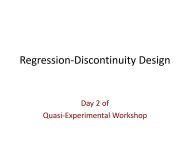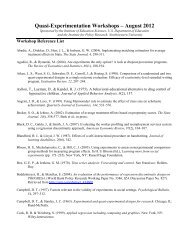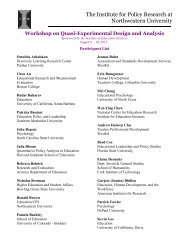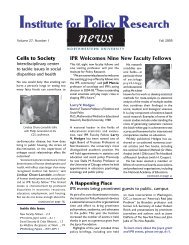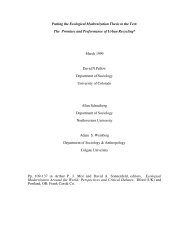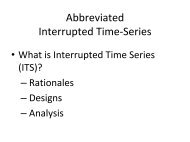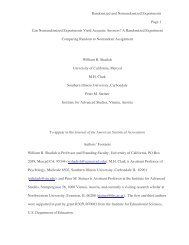Highlights of 2011 - Institute for Policy Research - Northwestern ...
Highlights of 2011 - Institute for Policy Research - Northwestern ...
Highlights of 2011 - Institute for Policy Research - Northwestern ...
You also want an ePaper? Increase the reach of your titles
YUMPU automatically turns print PDFs into web optimized ePapers that Google loves.
Child, Adolescent, AND Family Studies<br />
and career training <strong>of</strong> low-income parents to their children’s<br />
development through early childhood education centers. Past<br />
research by Chase-Lansdale and Sommer indicates that such<br />
a program could harness parents’ hopes <strong>for</strong> their children’s<br />
educational success as motivation <strong>for</strong> their own educational<br />
progress. In addition to early childhood education centers<br />
and community college healthcare work <strong>for</strong>ce programs,<br />
CareerAdvance® also provides a number <strong>of</strong> key supportive<br />
components—career coaches, financial incentives, and peer<br />
group meetings—to prepare parents <strong>for</strong> high-demand jobs<br />
in the healthcare sector. Chase-Lansdale was also selected as<br />
one <strong>of</strong> the inaugural fellows <strong>of</strong> the Aspen <strong>Institute</strong>’s Ascend<br />
Fellowship, which supports national leaders who are working<br />
to move families out <strong>of</strong> poverty using two-generation strategies<br />
(see p. 58).<br />
Welfare Re<strong>for</strong>m and Youth Outcomes<br />
Drawing upon the longitudinal data set called Welfare Children<br />
and Families: A Three-City Study, Chase-Lansdale and her colleagues<br />
examined the long-term strategies families have used to<br />
respond to welfare re<strong>for</strong>m, in terms <strong>of</strong> employment, schooling,<br />
residential mobility, and fertility from 1999 to 2006. In general,<br />
changes in mothers’ work and welfare patterns were not associated<br />
with deterioration or improvement in youth development.<br />
The few significant associations suggested that youth<br />
whose mothers increased employment were more likely to<br />
show declines in serious behavior problems and delinquency<br />
compared with youth whose mothers were unemployed or<br />
employed part-time during the study period. Welfare roll exits<br />
were unrelated to adolescent and young adult outcomes, and<br />
mothers’ employment transitions were linked to improvements<br />
in household income and mothers’ self esteem, in addition to<br />
reductions in financial strain and their own illegal activities. However,<br />
these associations did not explain the relation between<br />
maternal employment and youths’ improved behavior. The<br />
researchers also note that these results do not support the predictions<br />
<strong>of</strong> either supporters or opponents <strong>of</strong> welfare re<strong>for</strong>m.<br />
Underlying Problems <strong>of</strong> Delinquency<br />
Each year between 300,000 and 600,000 youth spend time<br />
in juvenile detention facilities around the nation, with a<br />
disproportionate number being low-income and minority<br />
youth. IPR economist Jonathan Guryan, with Sara Heller and<br />
Jens Ludwig <strong>of</strong> the University <strong>of</strong> Chicago, is examining the<br />
underlying problems that cause youth to become involved<br />
with delinquency and violence. Previous research indicates<br />
that deficits in noncognitive skills—such as self-regulation,<br />
impulse control, social in<strong>for</strong>mation processing, and moral<br />
reasoning—might account <strong>for</strong> involvement with, and relapses<br />
into, delinquency. Using a randomized experimental design<br />
and with support from the Smith Richardson Foundation, the<br />
researchers will begin collecting data on all the approximately<br />
4,000 male juveniles, most <strong>of</strong> whom are Latino or African<br />
American, entering a county juvenile detention system over<br />
14 months. These youth have been randomly assigned to<br />
either a typical residential center or one providing a cognitive<br />
behavioral therapy intervention to promote noncognitive skill<br />
development. The researchers have uncovered themes shared<br />
by a number <strong>of</strong> effective interventions, which might prove to be<br />
efficacious in part because they promote adaptive personality<br />
trait development.<br />
Maltreatment Among Detained Youth<br />
Childhood maltreatment is common among detained youths<br />
and is also highly associated with psychiatric disorders. As part<br />
<strong>of</strong> the <strong>Northwestern</strong> Project, a team <strong>of</strong> clinical researchers<br />
assessed the history <strong>of</strong> childhood maltreatment and psychiatric<br />
diagnosis <strong>for</strong> 1,829 youths detained at the Cook County Juvenile<br />
Temporary Detention Center. The project, led by behavioral<br />
scientist and IPR associate Linda Teplin, Owen L. Coon<br />
Pr<strong>of</strong>essor, is the nation’s largest longitudinal, epidemiological<br />
study <strong>of</strong> the mental health needs and outcomes <strong>of</strong> delinquent<br />
youth, many <strong>of</strong> whom are now young adults. Of those they<br />
interviewed <strong>for</strong> the study, more than three-quarters <strong>of</strong><br />
females and more than two-thirds <strong>of</strong> males had a history <strong>of</strong><br />
moderate or severe physical abuse. More than 40 percent <strong>of</strong><br />
females and 10 percent <strong>of</strong> males had a history <strong>of</strong> sexual abuse.<br />
Females and non-Hispanic whites had the highest prevalence<br />
rates <strong>of</strong> childhood maltreatment. Among youths who were<br />
sexually abused, abuse with <strong>for</strong>ce was associated with anxiety<br />
disorders among females and attention-deficit hyperactivity,<br />
or disruptive behavior disorders and substance use disorders,<br />
among males. Teplin calls <strong>for</strong> the mental health, child welfare,<br />
and juvenile justice systems to collaborate to ensure that these<br />
youth receive protection and care when they return to their<br />
communities. The article was published in Psychiatric Services.<br />
Children <strong>of</strong> Incarcerated Parents<br />
Sociologist and legal scholar John Hagan continues his work<br />
with Holly Foster <strong>of</strong> Texas A&M University to trace how<br />
having an incarcerated parent can affect a child’s life. Parental<br />
incarceration affects about one-fifth <strong>of</strong> elementary school<br />
children in the United States. Using data from the National<br />
Longitudinal Study <strong>of</strong> Adolescent Health <strong>for</strong> 2,000 children <strong>of</strong><br />
incarcerated fathers, Hagan and Foster are following the children<br />
into mid-adolescence and early adulthood. One finding is that<br />
having an imprisoned father and also attending a school where<br />
many other children have fathers in prison can lower college<br />
completion rates from 40 to 10 percent. Another finding is that<br />
these fathers go missing during a critical development period<br />
<strong>for</strong> the children, and this absence then follows their children<br />
through life, compounding their inability to complete college<br />
and severely limiting their future opportunities. Hagan is John<br />
D. MacArthur Pr<strong>of</strong>essor <strong>of</strong> Sociology and Law.<br />
15



